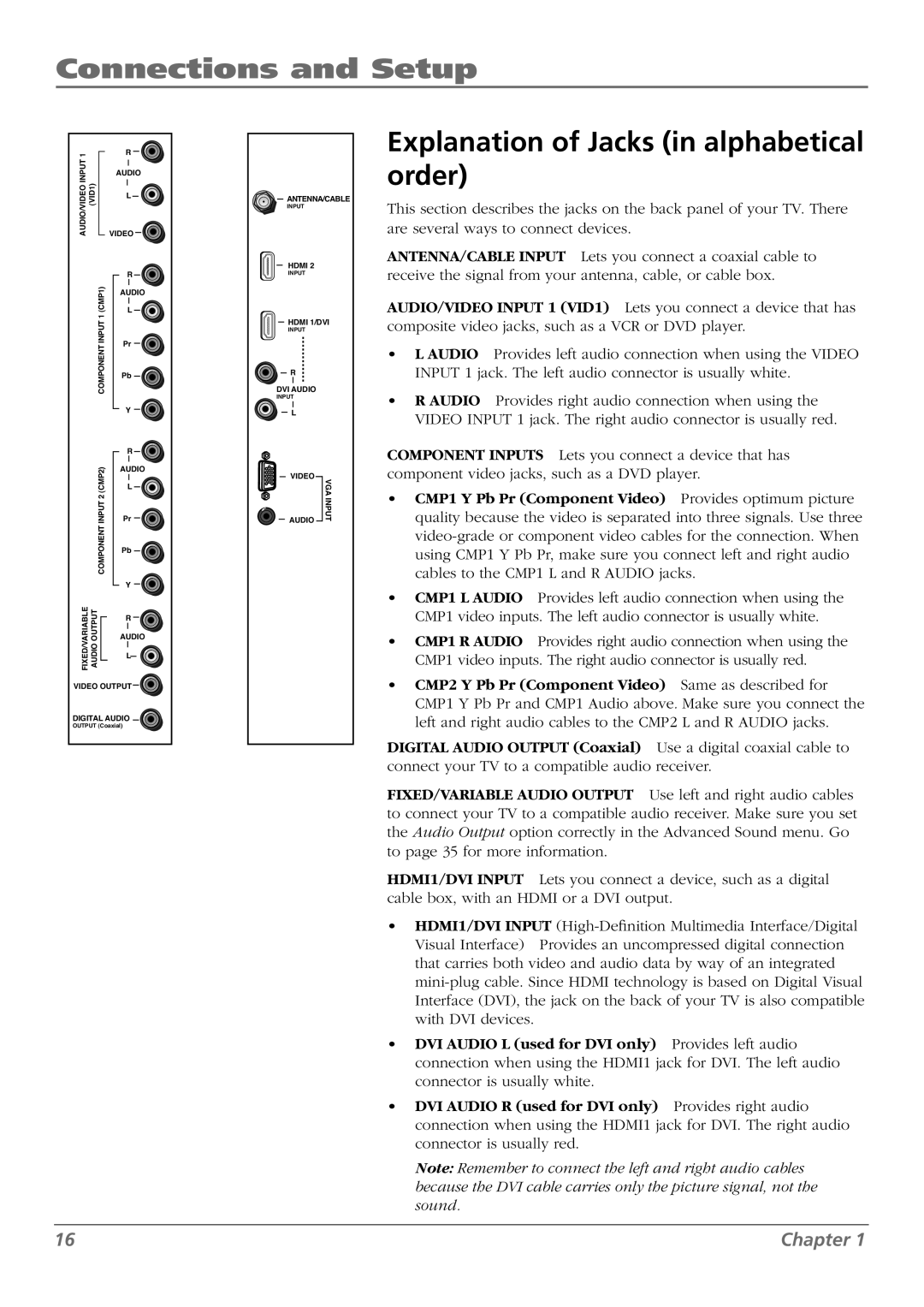
Connections and Setup
1 | R | |
INPUT | AUDIO | |
| ||
AUDIO/VIDEO (VID1) | L | |
VIDEO | ||
| R | |
(CMP1) | AUDIO | |
L | ||
INPUT 1 | Pr | |
COMPONENT | ||
Pb | ||
| ||
| Y | |
| R | |
INPUT 2 (CMP2) | AUDIO | |
L | ||
Pr | ||
COMPONENT | Pb | |
| ||
| Y | |
FIXED/VARIABLE AUDIO OUTPUT | R | |
AUDIO | ||
L | ||
| ||
VIDEO OUTPUT | ||
DIGITAL AUDIO | ||
OUTPUT (Coaxial) | ||
ANTENNA/CABLE | ||
INPUT |
| |
HDMI 2 |
| |
INPUT |
| |
HDMI 1/DVI | ||
INPUT |
| |
R |
| |
DVI AUDIO |
| |
INPUT |
| |
L |
| |
VIDEO | VGA INPUT | |
AUDIO | ||
| ||
Explanation of Jacks (in alphabetical order)
This section describes the jacks on the back panel of your TV. There are several ways to connect devices.
ANTENNA/CABLE INPUT Lets you connect a coaxial cable to receive the signal from your antenna, cable, or cable box.
AUDIO/VIDEO INPUT 1 (VID1) Lets you connect a device that has composite video jacks, such as a VCR or DVD player.
•L AUDIO Provides left audio connection when using the VIDEO INPUT 1 jack. The left audio connector is usually white.
•R AUDIO Provides right audio connection when using the VIDEO INPUT 1 jack. The right audio connector is usually red.
COMPONENT INPUTS Lets you connect a device that has component video jacks, such as a DVD player.
• CMP1 Y Pb Pr (Component Video) Provides optimum picture quality because the video is separated into three signals. Use three
•CMP1 L AUDIO Provides left audio connection when using the CMP1 video inputs. The left audio connector is usually white.
•CMP1 R AUDIO Provides right audio connection when using the CMP1 video inputs. The right audio connector is usually red.
• CMP2 Y Pb Pr (Component Video) Same as described for
CMP1 Y Pb Pr and CMP1 Audio above. Make sure you connect the left and right audio cables to the CMP2 L and R AUDIO jacks.
DIGITAL AUDIO OUTPUT (Coaxial) | Use a digital coaxial cable to |
connect your TV to a compatible audio receiver. | |
FIXED/VARIABLE AUDIO OUTPUT | Use left and right audio cables |
to connect your TV to a compatible audio receiver. Make sure you set the Audio Output option correctly in the Advanced Sound menu. Go to page 35 for more information.
HDMI1/DVI INPUT Lets you connect a device, such as a digital cable box, with an HDMI or a DVI output.
•HDMI1/DVI INPUT
Visual Interface) Provides an uncompressed digital connection that carries both video and audio data by way of an integrated
• | DVI AUDIO L (used for DVI only) | Provides left audio |
| connection when using the HDMI1 jack for DVI. The left audio | |
| connector is usually white. |
|
• | DVI AUDIO R (used for DVI only) | Provides right audio |
connection when using the HDMI1 jack for DVI. The right audio connector is usually red.
Note: Remember to connect the left and right audio cables because the DVI cable carries only the picture signal, not the sound.
16 | Chapter 1 |
